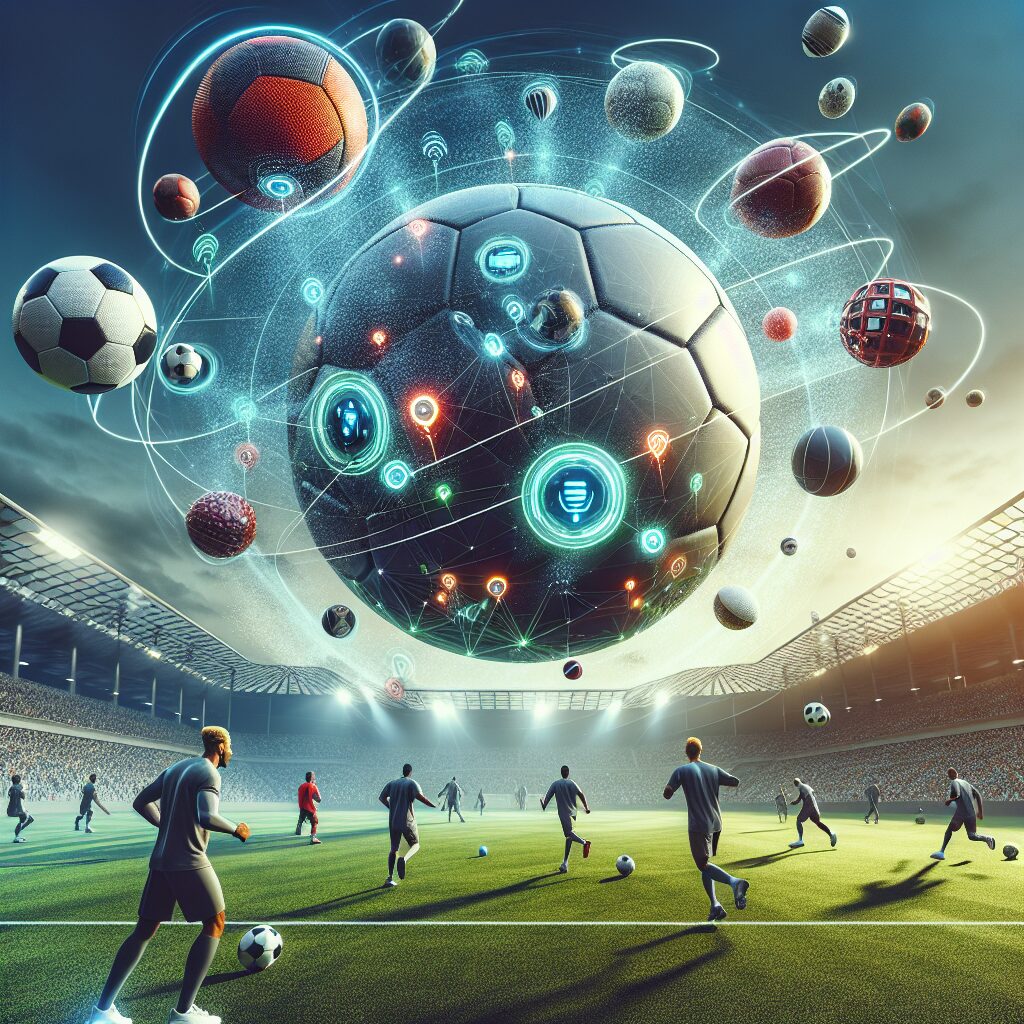The rapid advancements in technology have brought about a revolutionary transformation in various industries, and the world of sports is no exception. Enter the Internet of Things (IoT) adoption in sports, where we witness the rise of smart balls. These innovative sporting tools incorporate cutting-edge technology to enhance player performance, data analysis, and fan engagement. With sensors, GPS tracking, and wireless connectivity, smart balls are revolutionizing the way we play and experience sports.
One remarkable aspect of smart balls is their ability to capture a plethora of data points during gameplay. From tracking the speed and trajectory of a soccer ball to monitoring the spin and aim of a golf ball, these intelligent devices provide real-time insights for athletes and coaches to analyze. This wealth of data offers valuable feedback on performance, enabling players to enhance their skills and make informed decisions on the field or court. Moreover, with the integration of AI algorithms, smart balls can even provide personalized training programs based on an individual’s strengths and areas for improvement.
In the upcoming sections, we will delve deeper into the key takeaways of IoT adoption in sports and explore how smart balls are reshaping the way athletes train and compete. We will discuss their impact on injury prevention, player performance analysis, and how they have revolutionized fan engagement. So, let’s strap on our boots and get ready to explore the fascinating world of IoT adoption in sports and the rise of smart balls.
Key Takeaways
1. The article explores the increasing adoption of IoT technology in sports, with a particular focus on smart balls that can collect and analyze valuable data during games.
2. Smart balls offer numerous benefits, including enhanced training opportunities, improved performance analysis, and real-time feedback for athletes. They can monitor metrics such as speed, spin, trajectory, and impact force to provide valuable insights.
3. The integration of IoT in sports has also expanded to other areas such as smart stadiums and wearable devices. IoT-enabled smart stadiums allow fans to have a more immersive experience by providing real-time information and personalized content.
4. While the adoption of IoT in sports presents valuable opportunities, challenges remain, including data security and privacy concerns, as well as the need for standardization and interoperability across different IoT devices and platforms.
5. The future of IoT in sports looks promising, as technology continues to advance and innovate. The potential for IoT to revolutionize player performance, fan engagement, and overall sports experience is enormous, making it an exciting area to watch.
What are the Benefits of IoT Adoption in Sports: The Rise of Smart Balls?
Revolutionizing Sports with Smart Balls
Smart balls, powered by the Internet of Things (IoT), are transforming the way sports are played and analyzed. These technologically advanced sports equipment have embedded sensors and connectivity capabilities, enabling athletes and coaches to gather valuable data in real-time. This section will explore the various ways IoT adoption in sports, specifically through smart balls, is revolutionizing the industry.
Enhancing Performance and Training
One of the primary advantages of smart balls is their ability to enhance performance and training. With sensors that track movement, velocity, spin, and impact, athletes can obtain accurate and detailed insights into their technique and performance. This data is invaluable for coaches and athletes as it helps identify areas for improvement, optimize training regimens, and maximize performance on the field.
Preventing Injuries and Ensuring Safety
Safety is a crucial aspect of any sport, and IoT adoption through smart balls plays a significant role in injury prevention. The embedded sensors in smart balls can monitor the force and impact on players, providing real-time feedback on potential risks and the need for adjustments. By identifying risky scenarios and suggesting corrective measures, smart balls contribute to reducing the likelihood of injuries, thereby ensuring the safety of athletes.
Real-time Analysis and Decision Making
Thanks to the IoT integration in smart balls, coaches have access to real-time data analysis, leading to informed decision-making during games. These intelligent balls provide live insights on player positioning, ball trajectory, and performance metrics. Coaches can then make strategic decisions based on this data, improving the overall gameplay and increasing the chances of success. Real-time analysis also allows for immediate feedback to players, enhancing their on-field performance.
Promoting Fan Engagement
IoT adoption in sports is not limited to benefiting athletes and coaches; it also contributes to fan engagement. Smart balls provide enhanced data visualization during televised matches, offering viewers a deeper understanding of the game. With access to detailed statistics and analytics, fans can enjoy a more immersive and interactive sports experience. This technology-driven engagement creates a stronger connection between fans, players, and the sport itself.
Evolving the Ecosystem of Sports
The rise of IoT and smart balls is revolutionizing the entire ecosystem of sports. From athletes and coaches to fans and sporting equipment manufacturers, everyone is being influenced by this technological advancement. The adoption of IoT in sports is pushing boundaries, encouraging innovation, and shaping the future of sports as we know it.
How to Incorporate Smart Balls into Your Training Regimen?
1. Identify the specific needs and goals of your sport or activity.
2. Research and choose a smart ball that aligns with your requirements and budget.
3. Familiarize yourself with the technology and features of the smart ball.
4. Develop a training plan that utilizes the data collected by the smart ball.
5. Partner with a coach, trainer, or expert who can help interpret and utilize the data effectively.
6. Track your progress over time and make adjustments based on the insights provided by the smart ball.
7. Continuously explore new ways to leverage the smart ball technology to improve your performance and training regimen.
Conclusion
In conclusion, IoT adoption in sports, particularly through the use of smart balls, is revolutionizing the industry. These technologically advanced sports equipment offer a wide range of benefits, including performance enhancement, injury prevention, real-time analysis, fan engagement, and ecosystem evolution. By incorporating smart balls into training regimens, athletes can unlock their full potential and take their sports performance to new heights. So, why not embrace the power of IoT and join the rise of smart balls in sports?
Frequently Asked Questions
1. What are smart balls in the context of IoT adoption in sports?
Smart balls are sports balls equipped with IoT technology that allows them to gather and transmit data during gameplay. These balls use embedded sensors and connectivity features to provide real-time information, such as speed, trajectory, spin, and impact force.
2. How does IoT adoption in sports benefit athletes and teams?
IoT adoption in sports, particularly the use of smart balls, provides athletes and teams with valuable insights into their performance. By analyzing the data collected from smart balls, athletes can enhance their training and technique, improve overall performance, and reduce the risk of injuries.
3. Are smart balls only used for professional sports?
No, smart balls can be beneficial for athletes of all skill levels and across different sports. While professional teams may take advantage of advanced analytics for strategic decisions, amateur athletes can also benefit from the data provided by smart balls to refine their skills and track their progress.
4. How does IoT adoption in sports impact coaching and training?
IoT adoption in sports revolutionizes coaching and training methods. Coaches can use the data collected by smart balls to evaluate individual player performance, identify areas for improvement, and tailor training programs accordingly. It allows for personalized coaching and more effective skill development.
5. What are the challenges of IoT adoption in sports?
One of the challenges of IoT adoption in sports is the accuracy and reliability of the data collected by smart balls. Ensuring consistent sensor accuracy and preventing interference from external factors are areas that need improvement. Additionally, there may be concerns about data privacy and security.
6. Can smart balls be used in outdoor sports?
Yes, smart balls are designed to be used in both indoor and outdoor sports. They are built to withstand regular gameplay conditions, including impacts and adverse weather conditions, making them suitable for various outdoor sports such as soccer, basketball, and golf.
7. Can smart balls be used in competitive matches?
Yes, smart balls can be used in competitive matches and tournaments. They comply with regulations set by sports governing bodies while offering additional insights to athletes and audiences. However, their use in official matches might vary depending on specific sport regulations.
8. Are smart balls expensive compared to regular sports balls?
Smart balls tend to be more expensive than regular sports balls, primarily due to the embedded IoT technology and sensors. However, as technology advances and adoption increases, the costs are likely to decrease, making them more accessible to athletes and teams.
9. Are there any limitations to IoT adoption in sports?
One limitation of IoT adoption in sports is the potential reliance on technology over natural intuition and instinct. Additionally, limited IoT infrastructure in certain sports facilities or regions could pose challenges in implementing and utilizing smart balls to their full potential.
10. Can smart balls be used as training tools for recreational purposes?
Absolutely! Smart balls can provide recreational athletes with an exciting and interactive way to improve their skills. Whether it’s for fun or serious training, smart balls offer valuable data insights that can enhance the overall experience and help individuals track their progress.
Final Thoughts: The Rise of Smart Balls in IoT Adoption in Sports
The adoption of IoT technology in sports, specifically the rise of smart balls, has the potential to redefine the way athletes train, compete, and analyze their performance. These innovative sporting tools enable athletes from all levels to benefit from real-time data insights, improving their technique, making informed decisions, and ultimately elevating the overall sports experience.
As technology continues to advance, smart balls are expected to become more accurate, affordable, and widely accessible. This opens up exciting possibilities for sports development, coaching methodologies, and audience engagement. The marriage of sports and IoT brings forth an era of enhanced performance, data-driven strategies, and a deeper understanding of the intricacies of sports. The rise of smart balls marks a transformative shift in the sporting landscape, where technology and athleticism intersect for remarkable progress.




